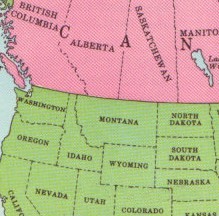Washington (U.S. state): Difference between revisions
Pat Palmer (talk | contribs) mNo edit summary |
(Climate) |
||
| Line 15: | Line 15: | ||
Rivers to the east of the Cascades drain into the [[Columbia River]] and its tributaries, ultimately emptying into the Pacific Ocean. To the west of the Cascades, rivers drain either directly into the Pacific or into Puget Sound. | Rivers to the east of the Cascades drain into the [[Columbia River]] and its tributaries, ultimately emptying into the Pacific Ocean. To the west of the Cascades, rivers drain either directly into the Pacific or into Puget Sound. | ||
==Climate== | |||
Washington has a maritime Pacific climate characterized by relatively heavy rainfall and governed by prevailing westerlies and the proximity of the Pacific Ocean with its generally moderating influence on temperatures. | |||
The presence of major mountain ranges adds an additional layer of influence resulting in the creation of a rain forest with very heavy rainfall (150 inches per year in places) on the west slopes of the Olympic Mountains and a pronounced rain shadow effect due to the Cascade Range. | |||
One result is a clear climactic demarcation between the moister, generally milder (both Summer and Winter) western portion of the state and the dryer, harsher eastern portion. | |||
Revision as of 11:52, 12 November 2022
Washington is one of the states of United States of America; it was admitted to the Union as the 42nd state on November 11, 1889. It lies at the northwest corner of the contiguous part of the US, in the Pacific Northwest region. Washington is bounded by the Canadian province of British Columbia on the north, Idaho on the east, Oregon on the south, and the Pacific Ocean on the west. The state has an area of 68,139 square miles (176,479 square kilometers) and an estimated population of 6,549,224 (2008).
The capital is Olympia. Most of the people live in the metropolitan areas of Seattle and Tacoma and other cities along Puget Sound. The University of Washington in Seattle was established in 1861.
Native American nations
Within the state lie about two dozen native American reservations, including two large ones of about 1,400,000 acres (~2200 sq mi.) each, the Yakama and Colville reservationis. Each of these large reservations includes a confederation of several tribes. Yakama is in the central part of the state near its southern border. Colville is in the north east part of the state.
Physiography
The state of Washington is divided by the Cascade Mountains into an eastern and a western portion. The Olympic Mountains lie on a peninsula to the west with the Strait of Juan de Fuca and Puget Sound extending inland from the Pacific Ocean between these two major mountain ranges.
The state has several distinct geographic regions, including the Olympic Mountains which feature a rain forest with up to 150 inches of precipitation per year on its western slopes. The Puget Sound lowlands extend from Canada to Oregon and feature excellent harbors. To the east lies the Cascade Mountains which feature several stratovolcanoes including Mount Rainier and Mount St. Helens which erupted most recently in 1981. The Columbia Plateau in the eastern portion of the state is a large basalt plain scarred by numerous coulees and featuring fertile, volcanic soil.
Rivers to the east of the Cascades drain into the Columbia River and its tributaries, ultimately emptying into the Pacific Ocean. To the west of the Cascades, rivers drain either directly into the Pacific or into Puget Sound.
Climate
Washington has a maritime Pacific climate characterized by relatively heavy rainfall and governed by prevailing westerlies and the proximity of the Pacific Ocean with its generally moderating influence on temperatures.
The presence of major mountain ranges adds an additional layer of influence resulting in the creation of a rain forest with very heavy rainfall (150 inches per year in places) on the west slopes of the Olympic Mountains and a pronounced rain shadow effect due to the Cascade Range.
One result is a clear climactic demarcation between the moister, generally milder (both Summer and Winter) western portion of the state and the dryer, harsher eastern portion.
